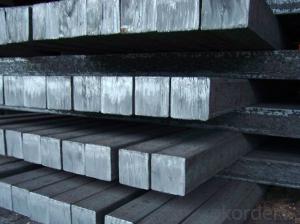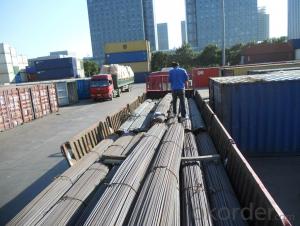Alloyed steel square bar
- Loading Port:
- China Main Port
- Payment Terms:
- TT OR LC
- Min Order Qty:
- -
- Supply Capability:
- -
OKorder Service Pledge
OKorder Financial Service
You Might Also Like
hot rolled square steel billet
1.Q195 Q235 Q345B
2.terms of payment: L/C T/T
3.size: 100~150mm length: 5.8~12m
4.certificate:GB
Type | Steel billet |
Standard Grade | a. 3SP/PS |
b. Q235 | |
c. 5SP d. Q275 | |
Size | 120mm x 120mm-150mm x 150mm etc. as per customers' requirement |
Length | 12m as standard |
Application | Carbon structural steel, Alloy steel, Gear steel, etc. |
Packing | standard export packing, or as per customers' requirement |
Quality | First quality |
Delivery time | Right now after the deposit. |
Others | 1. our products conform to all the standards |
2. we can offer special specification products as per our customers | |
3. we can offer the original mill test certificate and original production |
- Q:Can a steel square be used for checking the alignment of floor joists?
- Yes, a steel square can be used for checking the alignment of floor joists. A steel square, also known as a framing square, is a versatile tool commonly used in carpentry and construction. It has a triangular shape with a long arm and a shorter perpendicular arm, which makes it ideal for measuring and checking angles. When it comes to floor joists, a steel square can be used to check if they are properly aligned. By placing the long arm of the square against the side of a joist and extending the shorter arm to touch the adjacent joists, one can determine if the joists are parallel and evenly spaced. The square can also be used to check if the joists are perpendicular to the walls or other structural elements. In addition to checking alignment, a steel square can be used for various other tasks related to floor joists, such as marking and cutting them at the correct angles. It is a reliable and accurate tool that can help ensure the structural integrity and stability of a floor system.
- Q:Can a steel square be used for tile layout?
- Tile layout can definitely benefit from the use of a steel square. This tool, also referred to as a framing square or a carpenter's square, is incredibly versatile and has many applications in layout tasks. One of its main uses is for marking right angles and checking for squareness. When it comes to tile layout specifically, a steel square is great for ensuring that tiles are laid out in straight lines and at perfect right angles. It can also be used to measure and mark the starting point for tile installation, as well as to verify if the tiles are properly aligned and square throughout the installation process. However, it's important to remember that while a steel square is useful, it should be utilized alongside other tile layout tools like a chalk line or a laser level. This combination guarantees accurate and precise tile installation.
- Q:How accurate are steel squares for measuring?
- Steel squares are known for their high accuracy in measuring. Due to their sturdy construction and precise right-angle edges, they offer reliable measurements for various applications.
- Q:Can a steel square be used for marking out tenons?
- Yes, a steel square can be used for marking out tenons. A steel square, also known as a framing square or carpenter's square, is a versatile tool commonly used in woodworking and carpentry for making precise measurements and marking out angles. When marking out tenons, which are the projecting ends of a piece of wood that fit into a mortise, a steel square can be used to ensure accurate and square cuts. By aligning the square against the edge of the wood and marking the lines along its straight edges, woodworkers can achieve precise and consistent tenons. The square's sturdy construction and straight edges make it an ideal tool for marking out tenons and other woodworking joints.
- Q:Can a steel square be used for checking the levelness of a table saw top?
- No, a steel square is not suitable for checking the levelness of a table saw top. A precision level or a straight edge is more appropriate for this task as they provide better accuracy and ensure the table saw top is level.
- Q:How do you use a steel square to measure and mark compound angles?
- To use a steel square to measure and mark compound angles, you will need to follow a few steps. First, understand that a steel square, also known as a framing square, consists of two arms that meet at a right angle. One arm is longer, known as the blade, while the other is shorter, known as the tongue. The blade usually has measurements and markings for various angles. 1. Start by determining the desired compound angle you want to measure and mark. This involves identifying the two angles that make up the compound angle. For example, if you want to measure a compound angle of 45 degrees and 30 degrees, you need to measure and mark those two angles separately. 2. Position the steel square on the material you want to mark. Place the tongue against one side of the material and align the blade with the other side. Ensure that the square is firmly against the material, and the blade is parallel to the tongue. 3. Rotate the steel square until the desired angle is aligned with the material. Use the measurements and markings on the blade to determine the correct angle. For example, if you want to measure a 45-degree angle, align the 45-degree marking on the blade with the material. 4. Once the first angle is aligned, use a pencil or marking tool to mark the material along the blade of the steel square. This will create a line indicating the first angle. 5. Repeat the process for the second angle of the compound angle. Rotate the steel square again until the desired angle is aligned with the material, using the measurements and markings on the blade. Mark the material along the blade to indicate the second angle. 6. The intersection point of the two marked lines represents the compound angle you want to achieve. You can now use these marks as a guide for cutting, joining, or any other application where a compound angle is necessary. Remember, using a steel square to measure and mark compound angles requires accuracy in aligning the square and reading the measurements on the blade. Practice and experience will improve your proficiency in using a steel square effectively for compound angles.
- Q:How do you use a steel square for marking and cutting tenons?
- To use a steel square for marking and cutting tenons, first, ensure that the square is properly aligned and squared. Then, place the square against the edge of the timber and use the long side to mark the desired width of the tenon on the face and edge of the wood. Next, use a marking gauge to scribe the shoulder lines of the tenon along the face and edge. After that, use a backsaw or tenon saw to cut along the shoulder lines. Finally, use a chisel to remove the waste wood and refine the tenon to fit perfectly.
- Q:Can a steel square be used for metalworking tasks?
- A steel square has multiple applications in metalworking. Engineer's squares or machinist's squares, also referred to as steel squares, are precision tools extensively used in metalworking. These tools are typically made from hardened steel and possess precise right angles, which make them perfect for verifying and marking 90-degree angles in metal fabrication, welding, and machining procedures. Steel squares are frequently employed to ensure accuracy and alignment of metal components during layout, layout marking, scribing, and measuring tasks. Moreover, they can be utilized to examine the flatness and straightness of metal surfaces, as well as to square up workpieces during cutting or milling. Overall, steel squares are essential tools in the field of metalworking, providing valuable assistance in achieving precision and quality in a variety of metal-related tasks.
- Q:How do you use a steel square to ensure the correct angle for a dovetail joint?
- To use a steel square to ensure the correct angle for a dovetail joint, you would first align one edge of the square with the end grain of the board that will have the dovetail joint. Then, you would adjust the square until the desired angle is achieved, typically 90 degrees for a standard dovetail joint. Once the square is properly aligned, you can use it as a guide to mark the angle on the board, ensuring accurate and precise cuts for a perfect dovetail joint.
1. Manufacturer Overview |
|
|---|---|
| Location | |
| Year Established | |
| Annual Output Value | |
| Main Markets | |
| Company Certifications | |
2. Manufacturer Certificates |
|
|---|---|
| a) Certification Name | |
| Range | |
| Reference | |
| Validity Period | |
3. Manufacturer Capability |
|
|---|---|
| a)Trade Capacity | |
| Nearest Port | |
| Export Percentage | |
| No.of Employees in Trade Department | |
| Language Spoken: | |
| b)Factory Information | |
| Factory Size: | |
| No. of Production Lines | |
| Contract Manufacturing | |
| Product Price Range | |
Send your message to us
Alloyed steel square bar
- Loading Port:
- China Main Port
- Payment Terms:
- TT OR LC
- Min Order Qty:
- -
- Supply Capability:
- -
OKorder Service Pledge
OKorder Financial Service
Similar products
New products
Hot products
Related keywords



























